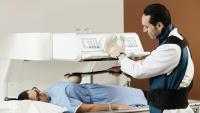Fluoroscopy

Make an Appointment
We have locations throughout Manhattan and Westchester. View all locations and contact info.
Fluoroscopy is an X-ray imaging technique doctors use to observe both the structure and function of organs in real time, including the bladder, kidneys, reproductive organs, and parts of the gastrointestional (GI) tract. During the exam, a specialized X-ray machine called a fluoroscope creates a sequence of images that are projected onto a monitor, enabling doctors to capture a moving image of your organs. To obtain the best images your doctor may have you take a liquid contrast agent (often barium) by mouth, intravenously, or via an enema. This agent enhances the clarity and definition of the area being examined.
How do I prepare for the test?
For some types of fluoroscopic exams your doctors will ask you abstain from eating and/or drinking beforehand. On the day of the test you should wear comfortable clothes, and you will be asked to change into a gown when you arrive at the fluoroscopy site. See below for specific instructions for different fluoroscopic procedures.
- Esophagram: During this test doctors evaluate the pharynx and esophagus while you drink a liquid containing enteric contrast. To prepare for this test take nothing by mouth for three hours beforehand. This procedure takes about 10 minutes.
- Upper GI Series: During this test doctors study the pharynx, esophagus, stomach, and part of the small intestine. To prepare for this test take nothing by mouth after midnight the night before. You will be given an enteric contrast shake to drink prior to the exam, which will take from 30 to 60 minutes.
- Lower GI series (barium enema): During this test doctors image the colon/large intestine as enteric contrast moves through it. To prepare for this test follow the directions for the 48-hour preparation in Fleet Enteric Contrast Enema Kit #2. This procedure takes about 30 to 60 minutes.
What will happen during the test?
During the exam we will ask you to lie on an exam table. The X-rays are generated by a machine below the table and are then registered by a detector suspended above the table and are then visible on a computer monitor. If your exam is to be done with contrast, a technician or nurse will explain how the agent works, and will give it to you intravenously, by mouth, or enema.
Are there any risks?
Although this is an X-ray based exam, you will be exposed to minimal doses of radiation. A small number of people develop a mild adverse reaction to the contrast agent. An even smaller number of people are allergic to the contrast agent and develop symptoms such as hives, itching, or red skin. Severe allergic reactions are very uncommon, and we are well-equipped to deal with them.
After the test
After the exam you can immediately resume your normal activities. A radiologist will analyze the images and share the results with the doctor who requested the exam. Your doctor will then discuss the results with you.

